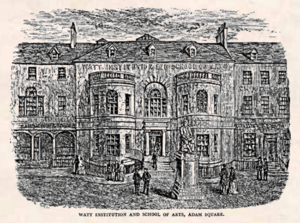Andrew Duncan (physician, born 1773) facts for kids
Quick facts for kids
Andrew Duncan, the younger
|
|
|---|---|
| Born | 10 August 1773 Edinburgh, Scotland
|
| Died | 13 May 1832 (aged 58) |
| Nationality | Scottish |
| Occupation | physician and academic |
Andrew Duncan, the younger (born August 10, 1773 – died May 13, 1832) was a Scottish doctor and a professor at the University of Edinburgh. He followed in his famous father's footsteps and became an important figure in medicine.
Contents
Life and Education
Andrew Duncan, the younger, was born in Edinburgh on August 10, 1773. His father was also a well-known doctor, Andrew Duncan, the elder. Young Andrew went to the High School in Edinburgh.
After school, from 1787 to 1792, he trained to be a surgeon with Alexander and George Wood in Edinburgh. He earned his Master of Arts (MA) degree in 1793 and his Doctor of Medicine (MD) degree in 1794.
Studying Abroad
Duncan continued his medical studies in London from 1794 to 1795. He learned from famous doctors like Matthew Baillie and William Cumberland Cruikshank.
He then traveled a lot in Europe. He visited medical schools in places like Göttingen (Germany), Vienna (Austria), Pisa (Italy), and Naples (Italy). During these trips, he met many leading scientists and doctors of his time.
Return to Edinburgh
When he came back to Edinburgh, he became a member of the College of Physicians of Edinburgh. He also worked as a doctor at the Royal Public Dispensary. He helped his father edit a medical journal called the Annals of Medicine. Later, he became a doctor at the Fever Hospital at Queensberry House.
In 1807, a new professorship was created at the University of Edinburgh for medical jurisprudence (the study of law and medicine) and public health. Andrew Duncan was chosen as the first professor for this new subject.
From 1809 to 1822, he was the secretary for the university's academic group and also its librarian. He also helped with rebuilding the university's buildings. In 1819, he became a joint professor with his father, teaching about the basics of medicine. In 1821, he became the professor of materia medica, which is the study of medical substances and their uses.
Andrew Duncan's health began to decline after a serious fever in 1827. He continued teaching almost until the end of his life. He passed away at his home at 45 York Place on May 13, 1832, when he was 58 years old.
He is buried in St Johns Churchyard in Edinburgh.
Important Works and Discoveries
Andrew Duncan, the younger, was a very active writer and editor in the medical field.
The Edinburgh New Dispensatory
In 1803, he published an important book called The Edinburgh New Dispensatory. This book was an improved version of an earlier work by William Lewis. It became very popular and was reprinted many times, even in the United States. It was also translated into German and French. He later published an update to this book in 1829.
Medical Journals
From 1805, Duncan was the main editor of the Edinburgh Medical and Surgical Journal. This journal became one of the most important medical publications of its time. He also wrote articles for the Edinburgh Review.
Other Contributions
In 1809, he wrote a "Treatise on the Diseases which are incident to Sheep in Scotland" for the Transactions of the Highland Society. This showed his interest in animal health too.
He also published Reports of the Practice in the Clinical Wards of the Royal Infirmary of Edinburgh in 1818. One of his notable discoveries was isolating a substance called cinchonin from cinchona bark. This was important for understanding how certain medicines worked.
- The Edinburgh new Dispensatory : containing 1. The Elements of pharmaceutical Chemistry ; 2. The Materia Medica; or the natural, pharmaceutical and medical History, or the Substances employed in Medicine ; 3. The pharmaceutical Preparations and Compositions ; including Translations of the Edinburgh Pharmacopoeia published in 1805, of the Dublin Pharmacopoeia in 1807, and of the London Pharmacopoeia in 1815. 8th Ed. Edinburgh : Bell & Bradfute, 1816. Digital Edition by the University and State Library Düsseldorf
- On the Diseases of Sheep
Students Trained by Duncan
Andrew Duncan taught many students who went on to become important doctors themselves. One notable student was James Scarth Combe, who became a surgeon and later the president of the Royal College of Surgeons of Edinburgh.
Family Life
Andrew Duncan was married to Mary Macfarquhar. Their daughter, Margaret Duncan, married William Scott of Teviot Bank.
Images for kids



